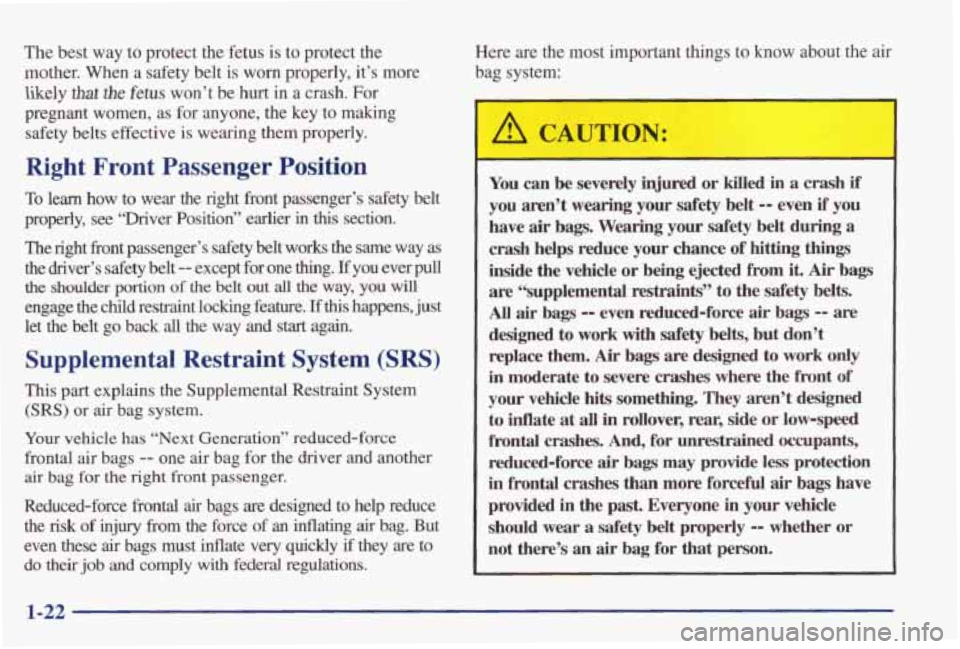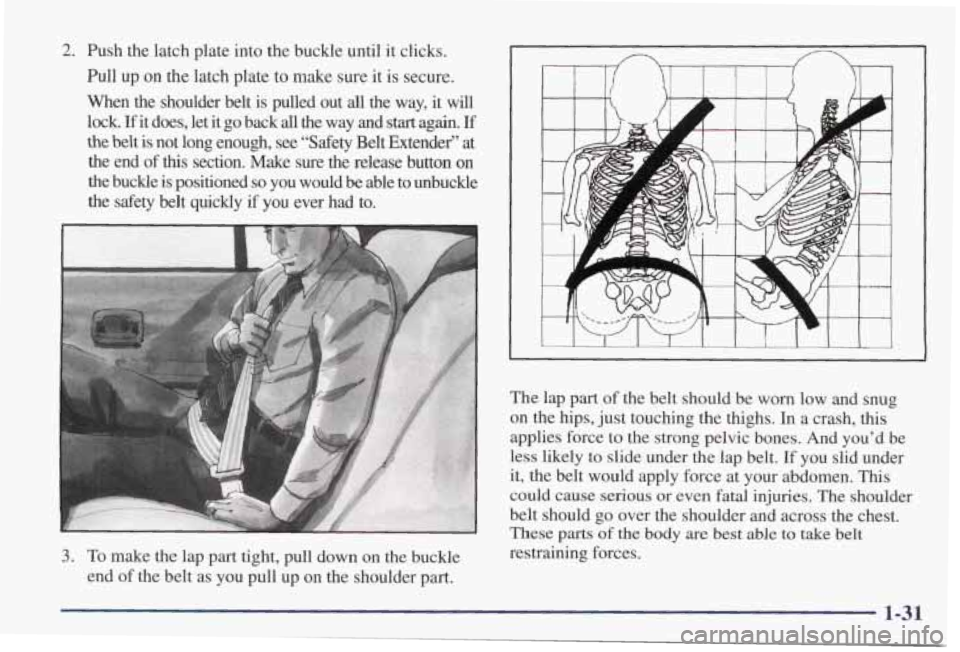Page 29 of 402

The best way to protect the fetus is to protect the
mother. When a safety belt is
worn properly, it’s more
likely
that the fetus won’t be hurt in a crash. For
pregnant women, as for anyone, the key to making
safety belts effective
is wearing them properly.
Right Front Passenger Position
To learn how to wear the right fiont passenger’s safety belt
properly,
see “Driver Position” earlier in this section.
The right front passenger’s safety belt works the same way
as
the driver’s safety belt -- except for one thing. If you ever pull
the shoulder portion of the belt out all the way, you will
engage the child restraint locking feature. If this happens, just
let the belt go back
all the way and start again.
Supplemental Restraint System (SRS)
This part explains the Supplemental Restraint System
(SRS) or air bag system.
Your vehicle has “Next Generation” reduced-force
frontal
air bags -- one air bag for the driver and another
air bag for the right front passenger.
Reduced-force
fiontal air bags are designed to help reduce
the risk of injury from
the force of an inflating air bag. But
even these
air bags must inflate very quickly if they are to
do their job and comply with federal regulations. Here are the most important things to
know about the air
bag system:
’
A CAUTION: I
You can be severely injured or killed in a crash if
you aren’t wearing your safety belt -- even if you
have air bags. Wearing your safety
belt during a
crash helps reduce your chance of hitting things
inside the vehicle or being ejected from it. Air bags
are %pplemental restraints” to the safety belts.
All air bags -- even reduced-force air bags -- are
designed to work with safety belts, but don’t
replace them.
Air bags are designed to work only
in moderate to severe crashes where the front of
your vehicle hits something. They aren’t designed
to inflate at
all in rollover, rear, side or low-speed
frontal crashes.
And, for unrestrained occupants,
reduced-force
air bags may provide less protection
in frontal crashes than more forcefid air bags have
provided
in the past. Everyone in your vehicle
should
wear a safety belt properly -- whether or
not there’s
an air bag for that person.
Page 37 of 402
Rear Seat Passengers
It’s very important for rear seat passengers to buckle up!
Accident statistics show that unbelted people in the rear
seat are hurt more often in crashes than those who are
wearing safety belts.
Rear passengers who aren’t safety belted can be thrown out
of the vehicle in a crash. And they can strike others
in the vehicle who are wearing safety belts.
Rear Seat Outside Passenger Positions
Lap-Shoulder Belt
The positions next to the windows have lap-shoulder
belts. Here’s how to wear one properly.
1. Pick up the latch plate and pull the belt across you.
Don’t let it get twisted.
The shoulder belt
may lock if you pull the belt across
you very quickly. If this happens, let the belt go back
slightly to unlock it. Then pull the belt across you
more slowly.
1-30
Page 38 of 402

2. Push the latch plate into the buckle until it clicks.
Pull up on the latch plate to make sure it is secure.
When the shoulder belt is pulled out
all the way, it will
lock.
If it does, let it go back all the way and start again. If
the belt is not long enough, see “Safety Belt Extendef’ at
the end of
this section. Make sure the release button on
the buckle is positioned
so you would be able to unbuckle
the safety belt quickly
if you ever had to.
3. To make the lap part tight, pull down on the buckle
end of the belt as you pull up on the shoulder part. The
lap part
of the belt should be worn low and snug
on the hips, just touching the thighs.
In a crash, this
applies force to the strong pelvic bones. And you’d be
less likely to slide under the lap belt.
If you slid under
it, the belt would apply force at your abdomen.
This
could cause serious or even fatal injuries. The shoulder
belt should go over the shoulder and across the chest.
These
parts of the body are best able to take beIt
restraining forces.
1-31
Page 39 of 402
The safety belt locks if there’s a sudden stop or a crash,
or if you pull the belt very quickly out of the retractor.
I A CAUTION:
You can be seriously hurt if your shoulder belt is
too loose. In a crash, you would move forward
too much, which could increase injury. The
shoulder belt should fit against
your body.
To unlatch the belt, just push the button on the buckle.
1-32
Page 54 of 402
5. Push the latch plate (F) into the buckle until it clicks.
Be sure
the buckle is free of any foreign objects that
may prevent you from securing the latch plates. If
you can’t secure a latch plate, see your dealer for
service before using the child restraint.
6. In a single motion, pull the other side of the harness
all the way out. Keeping the harness pulled all the
way out, place
it over the child’s shoulder.
4. Select only one side of the harness. Pull the lap part
of the harness out, and place the harness over
the
child’s shoulder.
If both sides of the harness are pulled out, the lap
parts will lock. If the lap parts lock, let both sides of
the harness
go back all the way so each side will
move freely
again. Then repeat this step, pulling
only one side of the harness out.
Page 55 of 402
7. Push the latch plate into the buckle until it clicks.
Pull on both latch plates to make sure they are secure. A
green indicator will show in each latch plate window (G).
If the harness locks before the latch plate reaches the
buckle, let the harness go all the way back so it will move
freely again. Then repeat Steps 6 and 7. Be sure to keep
the harness pulled all the way out until you buckle it.
Once both sides of the lap-shoulder harness are pulled
out
of the retractor and buckled, the harness will lock.
8. Now fasten the left and right halves of the shoulder
harness
clip together. The indicator window (H) on
the clip will show green when the two halves are
fastened together. The purpose
of this clip is to help
keep the harness positioned
on the child’s shoulders.
1-48
Page 56 of 402
An unfastened shoulder harness clip won’t help
keep the harness in place on the child’s shoulders.
If the harness isn’t on the child’s shoulders, it
won’t be able to restrain the child’s upper body
in a sudden stop or crash. The child could be
seriously injured. Make sure the harness clip is
properly fastened.
9. On both sides of the harness, pull up on the lap part a
little to be sure it’s locked.
If the harness isn’t locked, or if it becomes too tight,
unfasten the harness clip. Then unlatch the harness
by pushing the button
on the buckle, and let both
sides
of the harness go all the way back so they will
move freely again. Then, repeat Steps 4 through 8.
If the harness still doesn’t lock, don’t use the child
restraint. See your dealer to have the built-in child
restraint serviced.
1-49
Page 66 of 402
2. Pick up the latch plate, and run the lap and shoulder
portions of the vehicle’s safety belt through or
around the restraint. The child restraint instructions
will show
you how.
If the shoulder belt goes in front of the child’s face or
neck, put it behind the child restraint.
L
4. Pull the rest of the shoulder belt all the way out of
the retractor to set the lock.
3. Buckle the belt. Make sure the release button is
positioned so you would be able to unbuckle the
safety belt quickly if you ever had to.
1-59